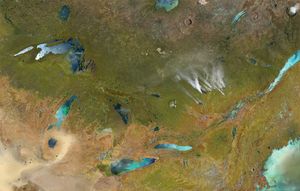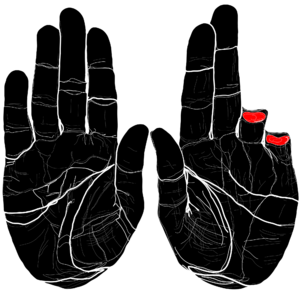Difference between revisions of "The Sum:About"
Anabellebel (talk | contribs) |
Anabellebel (talk | contribs) |
||
| Line 107: | Line 107: | ||
=== Inspiration === | === Inspiration === | ||
| − | The game features a world inspired by a myriad of post-apocalyptic science fiction games, movies and novels. The influences come from, among other things, the video game ''[[Wikipedia:Fallout|Fallout]]'' from which it was created, but also from a large collection of novels, including [[Wikipedia:The Dispossessed|''The Dispossessed'' (1974)]], [[Wikipédia:fr:Écotopie|''Écotopie'' (1975)], [[ | + | The game features a world inspired by a myriad of post-apocalyptic science fiction games, movies and novels. The influences come from, among other things, the video game ''[[Wikipedia:Fallout|Fallout]]'' from which it was created, but also from a large collection of novels, including [[Wikipedia:The Dispossessed|''The Dispossessed'' (1974)]], [[Wikipédia:fr:Écotopie|''Écotopie'' (1975)], [[Wikipedia:William S. Burroughs|''The Valley'' (1987)]], [[Wikipédia:fr:Future times|''Future times'' (1948)]], [[Wikipédia:fr:Anne Legault|''Récits de Médilhault'' (1994)]], [[Wikipedia:en:The Road|''The Road'' (2006)]], [[Wikipedia:en:Utopia (book)|''Utopia'' (1516)]], [[Wikipedia:Doris Lessing|''Mara and Dann'' (1999)]]; novel series such as [[Wikipedia:en:Dune (novel)|''Dune'' (1965)]], [[Wikipedia:en:Silo (series)|''Silo'' (2012)]]; movies such as [[Wikipedia:en:Blast from the Past (film)|''Blast from the Past'' (1999)]], [[Wikipedia:Logan's Run (film)|''Logan’s Run'' (1976)]], [[Wikipedia:en:The Salute of the Jugger|''The Salute of the Jugger'' (1989)]], [[Wikipedia:en:A Boy and His Dog|''Apocalypse 2024 (A Boy and His Dog)'' (1975)]], [[Wikipedia:en:Le Dernier Combat|''Le Dernier Combat'' (1983)]], [[Wikipedia:Blindness (2008 film)|''Blindness'' (2008)]], ''The Eternal night of the Twelve moons'' (2013), [[Wikipedia:Elysium (film)|''Elysium'' (2013)]], [[Wikipedia:THX 1138|''THX 1138'' (1971)]], as well as the [[Wikipedia:Mad Max|''Mad Max'' (1979-2015)]] film series. |
== Accueil == | == Accueil == | ||
Revision as of 02:29, 16 September 2022
| 1. Presentation | 2. How to play | 3. Crédits |
The Sum (french version: Nous Aurons) is a video game created by the artist Hugo Nadeau (hugonadeau.com) from the strategy video game Fallout Tactics (2001) developped by Micro Forté and published by 14 Degrees East. The game does not play out in the universe of Fallout. Its first demo version launched in 2015 and alpha version in 2017. Its beta is scheduled for late 2022. The game allows you to experience a post-state world following the anticipated impacts of climate change. The game is offered for free in solo mode on PC only.
In Short
Game type
Serious Role-playing game, video game of Wikipedia:Anticipation (fiction), The Sum can be seen as a radical "camping simulator", a post-anthropocene game, an artistic excavation in the humanity of tomorrow. It is proposed as a work of art in the sense of Alexander Afanasievich Potèbnia: "of thought by means of images". Desperate projection of utopias, its seeks to bring to life these anarchies that grow across North America.
Goal
The "goal" of the game is threefold:
- In priority, find a place to call home (already inhabited or not), even if it means settling alone in the middle of a territory devastated by global warming and the bankruptcy of the States.
- In a secondary way, conquering one's autonomy through learning (obtaining levels of autonomy) to act fully in the world.
- Survive, if only long enough to accomplish the first goal.
End of game
The game can potentially end at any time and any place. It therefore depends on the willingness and ability of the player character to end the game. Once the player has chosen a place to live permanently, the game validates a number of conditions for the game to end. Some hidden conditions may cause a "false endings" to be triggered, i.e., an ending that leads to death (i.e., a game failure) or to a stalemate (i.e., a continuation of the game under worsened conditions). In the case of a successful ending, a circumstantial text describing the immediate future of the main character is presented and a number of end game certificates are given as rewards.
End of game conditions
- Inhabited location
- Those who are already here have given their permission.
- There are no hostile individuals or groups in the area.
- Ghost town
- The place is not considered deadly (irradiated or too toxic).
- The player character has basic survival equipment: good clothes, a bed, a knife and something to make a fire (combustible materials, a lighter or enough knowledge in Survival to start a fire without a lighter)
- The player character has sufficient knowledge of Survival.
General content
The game features a collection of some ideal 25 cities inspired by anarchism, all colorful and somewhat exotic. They are indebted to, and sometimes attributable to, the Annares society (anarchist moon) of Ursula K. Le Guin's The Dispossessed.
Interpretation
As a work of fiction, The Sum seeks to offer a different narrative from other well-known fiction works, such as The Dispossessed, Oryx and Crake or Nineteen Eighty-Four. it mainly seeks to portray a global decentralization, anti-authoritarianism, or biocentrism. It is therefore a counterexample to Anthropocentrism. The project seeks to pierce through the predicted climatic consequences to show a new world where freedoms, mutual aid and direct democracies are energized and superposed in an open way.
Founding
The production of the game The Sum, its french version Nous Aurons, as well as some public presentations (online performances) of the project entitled Nous campions loin des endroits où la mort nous attendait were realized thanks to the support of the Conseil des arts et des lettres du Québec as well as the Canada Council for the Arts.
Synopsis
Intrigue
The events of the Predation, even if they seem recent, are shrouded in mystery and constantly debated. The prevalence of the year 2197 in many of the recovered tools, although it does not prove anything, offers a semblance of a common ground. Nevertheless, the traces left behind speak and ruptures are on everyone's lips.
Agriculture once stretched as far as the eye could see before giving rise to the Great American Desert, the Great Loto-Quebec Fireworks and the Black Plain. What were called the States were, but the States are no more. A "chorus virus", HaNa, decimated the populations. A large army destroyed cars faster than they came out of the factories. The Revenants (formerly called the Great Lakes), had now yet dried up. Across the Great Tongue, a tower in the middle of the waters exploded, covering the ocean with plastic. The Internet was unlimited, but the traces of it we find today, isolated, now reminds only as encrypted crumbs. The invisible radiation became flesh. But the humans were so numerous that they survived all the imaginable deaths.
It's already been generations since everything changed. It was the warming, now comes the real part. The Meric is a web that has no center, no fixed shape, and in its blood flows the freedom to find oneself.
Universe
The universe of The Sum (which is not the same as Fallout game franchise from which it was created) presents the atmosphere of a ruined world with equipment relative to a post-apocalyptic civilization, this one coming after the long fall of an industrial civilization of the 21th - 22th century (understood in the game as the period of the Predation).
Setting
The game takes place in North America (Merica) around the Great Lakes (Revenants) and along the former East Coast. For more details, see the game map.
Merica
When the game begins, Merica (the region corresponding to the Great Lakes and the U.S. East Coast) is an open territory, with no States and traversed by many specificities:
- There is no longer any centralized control of the territory (by the police or the military, for example)
- Decentralized, self-organized, sometimes federated communities occupy portions of the territory and can be visited.
- Wild animals, sometimes hostile, have repopulated natural areas and ex-cities in large numbers.
- Remnants of industrial civilization and recent conflicts (precarious buildings, pollution and radiation, landmines, debris) dot the territory and sometimes constitute a mortal danger.
- A significant rise in sea levels has swallowed up large swathes of coastal areas.
- Some natural disasters are still ongoing, such as droughts and forest fires.
- Armed groups have settled or are crossing certain regions.
Game system
General information
The Sum focuses on exploration and day-to-day survival. The player-triggered dialogues with the non-player characters take place autonomously according to the points (Skills and Traits) of the main character. The visited locations are either small scattered communities, connected by rare points of contact and technologies, or ghost towns occupied here and there by survivors. By meeting other characters, the player can initiate a dialogue, obtain informations or tasks, exchange goods, recruit friends (to change the composition of their group) and sometimes start an armed conflict. Occasionally, characters encountered may be encountered again elsewhere.
Start
After an initial situation that is usually disadvantageous (one must choose from 22 main characters who all have their own stories), the player can choose to stay or venture out into the world.
Equipment
The main character carries a GPSP (Global Positioning System Portable), a kind of electronic tablet that helps them to get information about the surroundings. It includes an interface to read electronic chips and USB keys, a battery and a GPS map whose data must be reconstructed. Thanks to a miniature subcutaneous generator, the tool recharges automatically from the body heat of its wearer.
The game features a large number of various objects and weapons that serve as witnesses to the past world, not always being useful to pick up.
Group
The game system allows the player to control several characters simultaneously, forming a group that follows the main character in their travels. In some specific places (communities or safe meeting places), it is possible to entrust or "drop off" characters that the player no longer wish to "keep", or welcome others.
Combat
The combat system in The Sum is continuous. All characters fight at the same time, with action points regenerated at a rate based on their Agility score. It is possible to change position (standing, crouching, prone), which affects the accuracy of attacks.Creation
Team
From 2013 to 2021, the production, programming, visual creation and writing of the game were led entirely by Hugo Nadeau. Antonio de Braga designed almost all of the game's music, while Fred Lebrasseur produced several sound environments.
Many people have contributed to the creation of the game, sometimes on a voluntary basis, sometimes by being paid and sometimes in an unauthorized way. For a list of these people, see The Sum:Credits
Founding
The Sum The Sum and several performances associated with it were funded by the Conseil des arts et des lettres du Québec (CALQ).
Inspiration
The game features a world inspired by a myriad of post-apocalyptic science fiction games, movies and novels. The influences come from, among other things, the video game Fallout from which it was created, but also from a large collection of novels, including The Dispossessed (1974), [[Wikipédia:fr:Écotopie|Écotopie (1975)], The Valley (1987), Future times (1948), Récits de Médilhault (1994), The Road (2006), Utopia (1516), Mara and Dann (1999); novel series such as Dune (1965), Silo (2012); movies such as Blast from the Past (1999), Logan’s Run (1976), The Salute of the Jugger (1989), Apocalypse 2024 (A Boy and His Dog) (1975), Le Dernier Combat (1983), Blindness (2008), The Eternal night of the Twelve moons (2013), Elysium (2013), THX 1138 (1971), as well as the Mad Max (1979-2015) film series.
Accueil
De façon générale, le jeu a été très bien reçu, tant auprès des amateur.ice.s de jeux vidéos que d'art.
- Modb.com : 9,3/10





